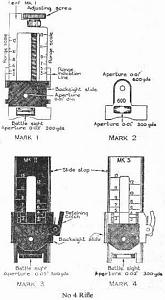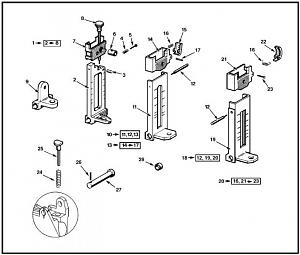
Originally Posted by
Outpost75

I think I've seen that rifle somewhere before...
I was curious about the Fairtrimmer's stock oil, wondering how it differed from the ol' boiled linseed oil. A brief DuckDuckGo search indicated that it might not be available anymore. I didn't look too hard however. Many rifles like mine don't really need much in the way of stock maintenance - most of the time they're nice and snug in the gun safe; and they only come out for nice days on the range. A little different than being out in the elements 24/7 during a war, or even days of hunting in varying conditions.
Noticing the sight you have mounted on your Long Branch, you probably are aware, but for those who aren't, a period correct alternate sight for the Long Branch and other No. 4 Mk 1 rifles is the earlier Mk 1"Singer" variant of the ladder sight. The sight shown in your pictures superseded the Singer sight for expediency and simplicity of manufacturing during war. Both can be found on Fleabay and elsewhere, although prices are starting to really go up...
The advantage of the Singer is that it is thumbscrew click-adjustable for elevation, with 50 yard graduations on the ladder, 25 yards per click, i.e. four clicks from the 200 yard zero will take you to 300 yards, etc and so forth. To swap them out, you simple remove the stake securing the sight axis pin, lift out the current sight - making sure the tensioning catch pin and spring don't launch themselves into the surrounding environment by simply cupping your hand over the sight as you lift it - then put everything back with the different sight in place.
Soooooo... whatever handload either cast or jacketed makes your Lee Enfield sing at whatever distance, there's probably a click that will get you pretty darned close.
Crappy picture follows that I just grabbed with my old steam powered cellphone. And BTW, let me take a moment to thank you for all the knowledge and help you've shared over many, many years in many venues. For myself and many others, it has really made a difference.


The elevation table below is for half minute adjustable competition sights from A.J. Parker and Parker-Hale, but may be useful as it gives the differences in minutes between ranges with .303 British Mk VII ball ammunition. The Mk 1 Singer, click adjustable sight, obviously, is not in half minute of angle clicks.

The No 4 rifles may be fitted with one of the four following back sight assemblies, see Figure 2-9:
a. Mk 1 (1). The Mk I back sight is a folding leaf type sight with a screw type adjustment for ranges from 182.88 metres to 1188.72 metres (200 yards to 1300 yards) with click stops at 22.86 metres (25 yard) increments. The scale is marked in increments of 91.44 metres (100 yards);
b. Mk 2 (2). The Mk 2 back sight is a dual range flipsight with apertures set for 274.32 metres and 548.64 metres (300 yards and 600 yards);
c. Mk 3 (3). The Mk 3 back sight is a leaf type sight with a click type sliding range adjustment. The range setting is adjustable from 182.88 metres to 1188.72 metres (200 yards to 1300 yards) in increments of 91.44 metres (100 yards).
d. C Mk 4 (4). The C Mk 4 or Canadian Mk 4 back sight is also a folding leaf type sight. It is similar in nature to the Mk 3 sight, however, the slide catch has been redesigned to reduce the susceptibility of the catch to damage. It is adjustable from 182.88 metres to 1 188.72 metres (200 yards to 1 300 yards) in increments of 91.44 metres (100 yards).


Don't mind the S&K mount and scope in the background - it only goes on the Long Branch when doing load development because something new came along.














 Reply With Quote
Reply With Quote















